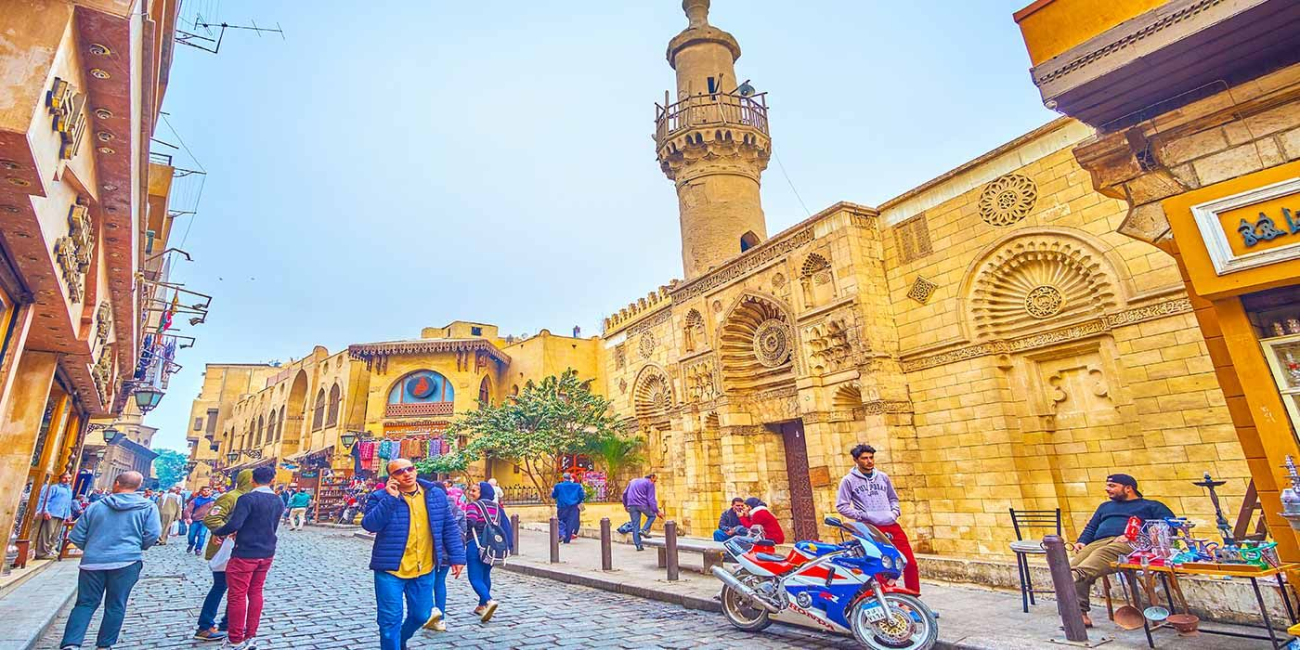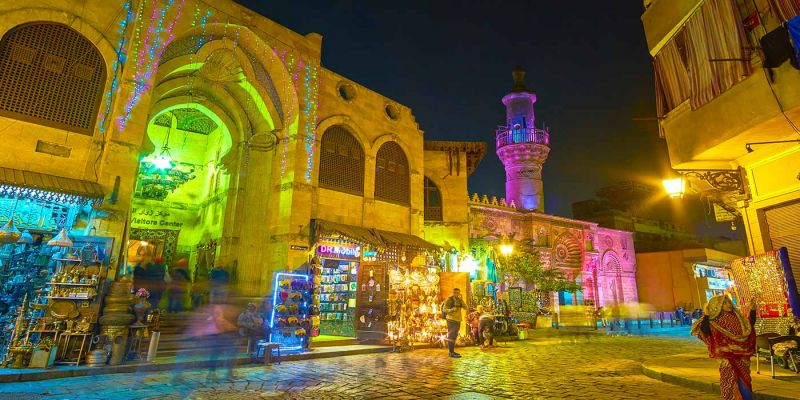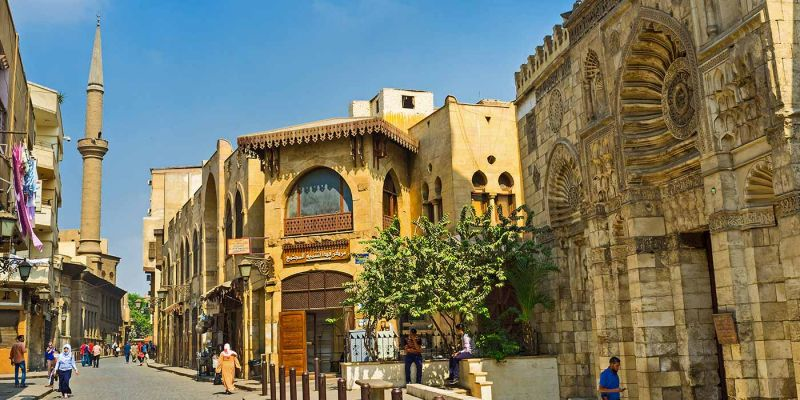-
Home
- Egypt
- Egypt Travel Guide
- Cairo Attractions
- Al Aqmar Mosque | Cairo | Egypt
Al Aqmar Mosque | Cairo | Egypt
Al Aqmar Mosque was built by al-Ma'mun al-Bata'hi, wazir of the Fatmid Khalif-Amir, in 1125. Click here to know more about Egypt Islamic history through Memphis tours!

Highlights of Islamic Cairo:
Some of the greatest sights of Islamic Cairo are located in Al-Muizz Al-Deen Street. This street was the main street in the city when it was built back in the 11th century and it is also where mausoleums and palaces were constructed. The northern section of the street (between Bab El-Fotouh and Al-Azhar Street) was recently restored and opened for visitors. This is one of the most picturesque parts of Cairo and that’s why people enjoy spending their time there. The Qala’un Complex here is one of the impressive sights in the city.
The southern part of Islamic Cairo offers some of Cairo’s largest Islamic monuments. One of the best examples of Islamic construction is Cairo’s Citadel. The construction of Cairo’s Citadel began under the Ayyubid general Salah Ad-Din Al Ayyubi in the 12th century. There are three notable mosques inside the walls of the citadel which are: Al-Nasir Muhammed Mosque, Suleyman Pasha Mosque, Muhammed Ali’s Alabaster Mosque, and Al Aqmar Mosque.

One of the impressive and oldest buildings of old Islamic Cairo down El Moez Street is Al Aqmar Mosque. This small, but unique mosque along Al-Muizz Street is one of the oldest buildings in Islamic Cairo. The builders of Al-Qahira, the walled city that today forms the core of Islamic Cairo, were the Fatimids, who ruled Egypt from 969 until 1171. Originating from present-day Tunisia, they conquered Egypt and installed their Shi’a Islamic ideology as the religion of the state.
Who built Al-Aqmar Mosque?
Al-Aqmar Mosque, or the Moonlight Mosque, has several unique architectural features. It was the first mosque in Cairo to use an offset façade—allowing the facade to remain square to the street front, while the rest of the building sits at an angle, aligning with the qibla, the direction of prayer toward Mecca.
Al Aqmar mosque was built during the Fatimid period in 1125 AD under the rule of Al-Ma’mun Al Bata’ihi. Some historians believe that the mosque was originally built during the caliphate of Imam Al Amir bi-Ahkami l-Lah; while others still claim that it was built during the caliphate of Al Mustansir.

The construction of Al-Aqmar Mosque:
The facade itself is also quite unique, decorated with three fluted hoods around the portal and to either side as well as beautiful inscriptions. Many of the features of this mosque later became common in Cairene mosque architecture. The Mosque’s façade is also known for its detailed stonework, while the interior part welcomes all its visitors with a fresh, cooling breeze.
Al Aqmar mosque is considered one of the first hanging mosques in the history of Old Cairo and was originally built higher than street level, above a shopping area and a souk. However, the mosque now appears to be at street level, as the shops kept going higher. The mosque was the first of its kind to be designed with an entrance parallel to the street and adjusted to align with the existing street plan, as opposed to facing the prayer’s Qibla, Mecca. Some historians claim that the mosque’s ceiling was re-done during the restorations of Mamluk Amir Yallugha Al-Salami as this type of architecture was unfamiliar during the Fatimid period.
- You Can Visit Al Aqmar Mosque by booking one of our Cairo Excursions.
Customize Your Dream Vacation!
Get in touch with our local experts for an unforgettable journey.
Plan Your TripEgypt Pyramids
- Dahshur Pyramids | Egypt Pyramids
- How Were the Pyramids Built?
- The Bent Pyramid at Dahshur
- Khafre Pyramid (Pyramid of Chefren)
- Pyramid of Khufu (Cheops Pyramid)
- Pyramid of Menkaure (Mykerinus Pyramid)
- Djoser Step Pyramid at Saqqara
- Giza Necropolis
- The City of Memphis, Egypt
- Saqqara Step Pyramid Egypt
- The Red Pyramid at Dahshur
ِAncient Egyptian History
- The Middle Kingdom of Ancient Egypt
- Alexander the Great | Egypt History
- Queen Hatshepsut
- King Tutankhamun Facts
- Salah Al-Din Al-Ayyubi
- King Ramses II: Facts, Accomplishments, Life and Death
- Sultan Mohammad Ali
- Amr Ibn Al-Aas
- The Old Kingdom of Ancient Egypt
- The New Kingdom of Ancient Egypt
- Greco-Roman Period
- Early Islamic Period in Egypt
- Mamluk and Ottoman Period
- Egypt in the Modern Era
- Behind the Throne: Exploring the Life and Reign of Queen Cleopatra of Egypt
Cairo Attractions
- Al Aqmar Mosque | Cairo | Egypt
- Sultan Al Mansur Qalawun Mosque
- Al Azhar Mosque
- Mosque of Amr ibn al-As: Egypt’s Oldest Mosque and a Living Chronicle of Faith
- Bab Zuweila
- Museum of Islamic Art
- Sultan Hassan Mosque & Madrasa | Islamic Cairo
- Ahmed Ibn Tulun Mosque
- Bayt Al Suhaymi in Cairo
- Cairo Opera House
- The Coptic Museum in Cairo
- The Egyptian Museum in Cairo
- El Ghorya | Attractions in Cairo Egypt
- Ben Ezra Synagogue | Coptic Cairo
- Khan El Khalili Bazaar
- Old Cairo and Coptic Cairo
- Salah El Din Citadel in Cairo | Egypt
- The Hanging Church | Coptic Cairo
- Al-Muizz Al-Deen Allah Street
- Downtown Cairo
- Zamalek / Gezira
- Islamic Cairo
- Souk Al Khayamiya | Tentmakers Bazaar
Alexandria Attractions
- City of Alexandria
- El Ain El Sokhna | Red Sea Egypt
- El Sharkia Governorate History | Egypt Cities
- The Faiyum Travel Guide | Egypt
- Port Said Travel guide | Egypt
- Marsa Alam Information
- Aswan High Dam | The High Dam of Egypt
- Qaitbay Citadel in Alexandria
- Pompey's Pillar in Alexandria
- Why El Alamein Egypt Became World War II's Most Important Battlefield
- Alexandria Egypt | Pearl of the Mediterranean
- Alexandria Library Egypt | Bibliotheca Alexandria
- Experience the Heart of the Mediterranean: Your Guide to the Best Things to Do in Alexandria, Egypt
- Cairo Travel information | Cairo Egypt
- The Catacombs of Kom el-Shuqafa
- Greco-Roman Museum
- Lighthouse of Alexandria
- Luxor Travel Guide | Luxor City | Egypt
- Montazah Park Alexandria
- Red Sea Egypt | Red Sea Travel Guide
- The Western Desert of Egypt | Egypt Oases
Luxor Attractions
Aswan Attractions
Nile Valley
Red Sea and Sinai
Ports of Call
Egyptian Culture and Travel Info
Explore Cairo's museums, starting with the Grand Egyptian Museum (GEM) and then head to the Egyptian Museum.
Discover Giza Pyramids Tour Visiting the Pyramids and the Sphinx, then the older Step Pyramid at Sakkara. Witness the greatest of Ancient Egypt in Cairo all in one day.
Sooth your night with Cairo Nile Dinner Cruise and oriental dance show on board of Nile Cruise Restaurant, Admire the lights of Cairo while enjoying a dinner with a belly dancing and Egyptian folklore show.
While your ship waits in Sokhna, escape to Cairo to see Ancient Egypt. This day trip will take you to see the Pyramids of Giza, guarded by the Great Sphinx, and the GEM. It is the perfect way to get a quick glimpse of Egypt’s ancient past.
Plan Your Trip!
You Might Also Like

Al Aqmar Mosque was built by al-Ma'mun al-Bata'hi, wazir of the Fatmid Khalif-Amir, in 1125. Click here to know more about Egypt Islamic history through Memphis tours!

Visit Sultan Al Mansur Qalawun Mosque in Islamic Cairo—Marvel at this Mamluk masterpiece and learn about its fascinating historical significance.

Uncover the significance of Al Azhar Mosque, Cairo’s grand mosque and prestigious university—a cornerstone of Islamic heritage and learning.

Journey into Egypt’s past at the Mosque of Amr ibn al-As. Learn its history and explore this cornerstone of Islamic culture in Cairo.

Journey through Old Cairo’s history at Bab Zuweila. Uncover stories, architecture, and secrets of this legendary city gate.

Explore the Museum of Islamic Art, Doha’s cultural gem. Witness stunning collections where the story of Islamic art and history beautifully unfolds.

Although it stands in the shadow of the Citadel, Sultan Hassan’s Madrassa-Mosque still manages to make a strong impression. The building is a massive example of Mamluk architecture, constructed during the 14th century reign of a sultan who was famous for his extravagant spending.

Step into history with Ahmed Ibn Tulun Mosque. Learn about its stunning architecture, captivating past, and importance in Islamic culture.

Discover Bayt Al Suhaymi Cairo—an authentic glimpse into Ottoman life. Visit beit el seheimy for rich architecture, culture, and history.

Discover the history and charm of the Cairo Opera House, Egypt’s hub for music, ballet, and cultural performances. Plan your visit today.

The Coptic Museum lies behind the walls of the famous Roman fortress of Babylon in the ancient district of Cairo (Misr Al-Qadima).

The Egyptian Museum is hard to miss on any tour of Cairo. Opening in 1902, it was purpose-built to house the antiquities of Ancient Egypt.

The complex was a built as a unique, multi-use space. It included the mosque and the mausoleum, but also a sabil that provided free water to the people, administrative space, and a covered market among other things.

Located deep in the winding alleys of Coptic Cairo, Ben Ezra Synagogue is the oldest Jewish temple in Cairo, dating from the 9th century AD.

No trip to Cairo would be complete without a visit to Khan Al-Khalili. The bazaar is loud, crowded, colorful, and exciting—full of all kinds of goods and shiny baubles.

The district of Old Cairo ( Masr al-Qadima in Arabic ) is Located in the south part of the city, on the right bank of the Nile opposite to the Island of Roda. Know More!

Salah El Din (known as Saladin to European historians) overthrew the Fatimid dynasty in 1171 AD, establishing the new Sunni Ayyubid Caliphate.

The most famous site in Coptic Cairo is the Church of the Virgin Mary, better known by its nickname, the Hanging Church. Learn more!

Egyptians refer to Downtown as Wust al-Balad, which can be poetically understood to mean “the heart of the country”. This crowded, bustling district of Cairo certainly lives up to the name.

Gezira is the Arabic word for island, but in Cairo, it is most commonly used to refer to a specific island in the middle of the Nile between Downtown Cairo and the area in Giza known as Dokki.

Islamic Cairo is the historic core of the city. When the Fatimid dynasty conquered Egypt in 969 AD, they constructed a new capital north of the existing city to serve as their administrative center.

Just beyond the southern walls of Fatimid Cairo across the street from Bab Zuweila stands a singular space in modern Cairo.

When the Fatimids took control of Egypt in 969 AD, high taxes and poor governance by the Ikhshidid Abbasidds, who had ruled Egypt since 905 AD, had ravaged the region and its capital, Fustat.






